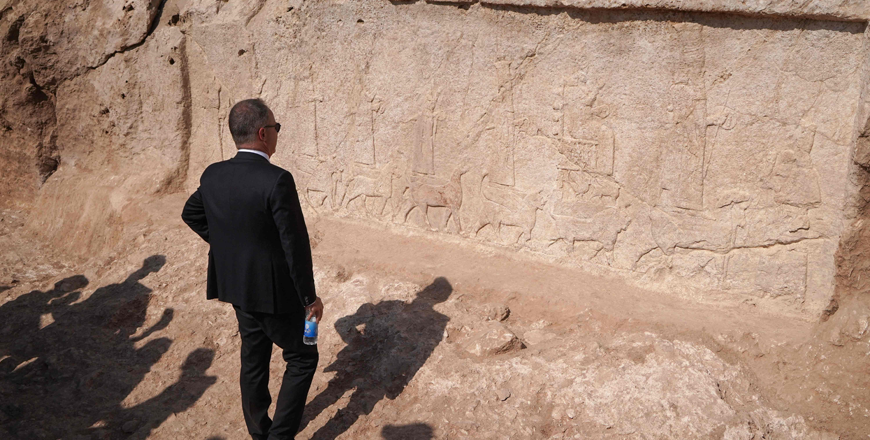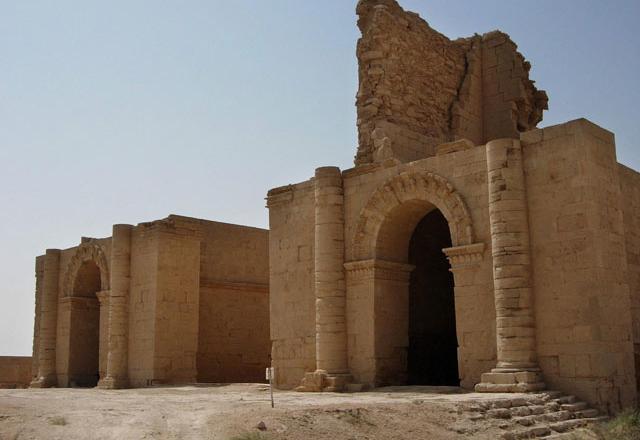You are here
Ancient carvings discovered at iconic Iraq monument bulldozed by Daesh
By AFP - Oct 19,2022 - Last updated at Oct 19,2022

Iraqi workers excavate a rock-carving relief recently found at the Mashki Gate, one of the monumental gates to the ancient Assyrian city of Nineveh, on the outskirts of what is today the northern Iraqi city of Mosul on Wednesday (AFP photo)
MOSUL — When Daesh group fighters bulldozed the ancient monumental Mashki gate in the Iraqi city of Mosul in 2016, it was part of the extremists' systematic destruction of cultural heritage.
Now, US and Iraqi archaeologists working to reconstruct the site have unearthed extraordinary 2,700-year-old rock carvings among the ruins.
They include eight finely made marble bas-relief carvings depicting war scenes from the rule of the Assyrian kings in the ancient city of Nineveh, a local Iraqi official said on Wednesday.
Discovered last week, the detailed carvings show a soldier drawing back a bow in preparation to fire an arrow, as well as finely chiselled vine leaves and palms.
The grey stone carvings date to the rule of King Sennacherib, in power from 705-681 BC, according to a statement from the Iraqi Council of Antiquities and Heritage.
Sennacherib was responsible for expanding Nineveh as the Assyrians' imperial capital and largest city — siting on a major crossroads between the Mediterranean and the Iranian plateau — including constructing a magnificent palace.
Fadel Mohammed Khodr, head of the Iraqi archaeological team working to restore the site, said the carvings were likely taken from Sennacherib's palace and used as construction material for the gate.
"We believe that these carvings were moved from the palace of Sennacherib and reused by the grandson of the king, to renovate the gate of Mashki and to enlarge the guard room", Khodr said.
'Iconic'
When they were used in the gate, the area of the carvings poking out above ground was erased.
"Only the part buried underground has retained its carvings," Khodr added.
ALIPH, the Swiss-based International Alliance for the Protection of Heritage in Conflict Areas, said the Mashki gate had been an "exceptional building".
Daesh targeted the fortified gate, which had been restored in the 1970s, because it was an "iconic part of Mosul's skyline, a symbol of the city's long history", it added.
ALIPH is supporting the reconstruction of the Mashki Gate by a team of archaeologists from Iraq’s Mosul University alongside US experts from the University of Pennsylvania.
The restoration project, which is being carried out in collaboration with Iraqi antiquities authorities, aims to turn the damaged monument into an educational centre on Nineveh’s history.
Iraq was the birthplace of some of the world’s earliest cities.
It was also home to Sumerians and Babylonians, and to among humankind’s first examples of writing.
But in the past decades, Iraq has been the target of artifacts smuggling. Looters decimated the country’s ancient past, including after the 2003 US-led invasion.
Then, from 2014 and 2017, the Daesh group demolished pre-Islamic treasures with bulldozers, pickaxes and explosives. They also used smuggling to finance their operations.
Iraqi forces supported by an international coalition recaptured Mosul, the extremists’ former bastion, in 2017.
Related Articles
DOHUK, Iraq — Archaeologists in Iraq revealed on Sunday their discovery of a large-scale wine factory from the rule of the Assyrian kings 2,
FAIDA, Iraq — Authorities in northern Iraq on Sunday unveiled an “archaeological park” of 2,700-year-old carvings from the rule of the
Daesh militants have destroyed ancient remains of the 2,000-year-old city of Hatra in northern Iraq, the tourism and antiquities ministry said on Saturday.


















